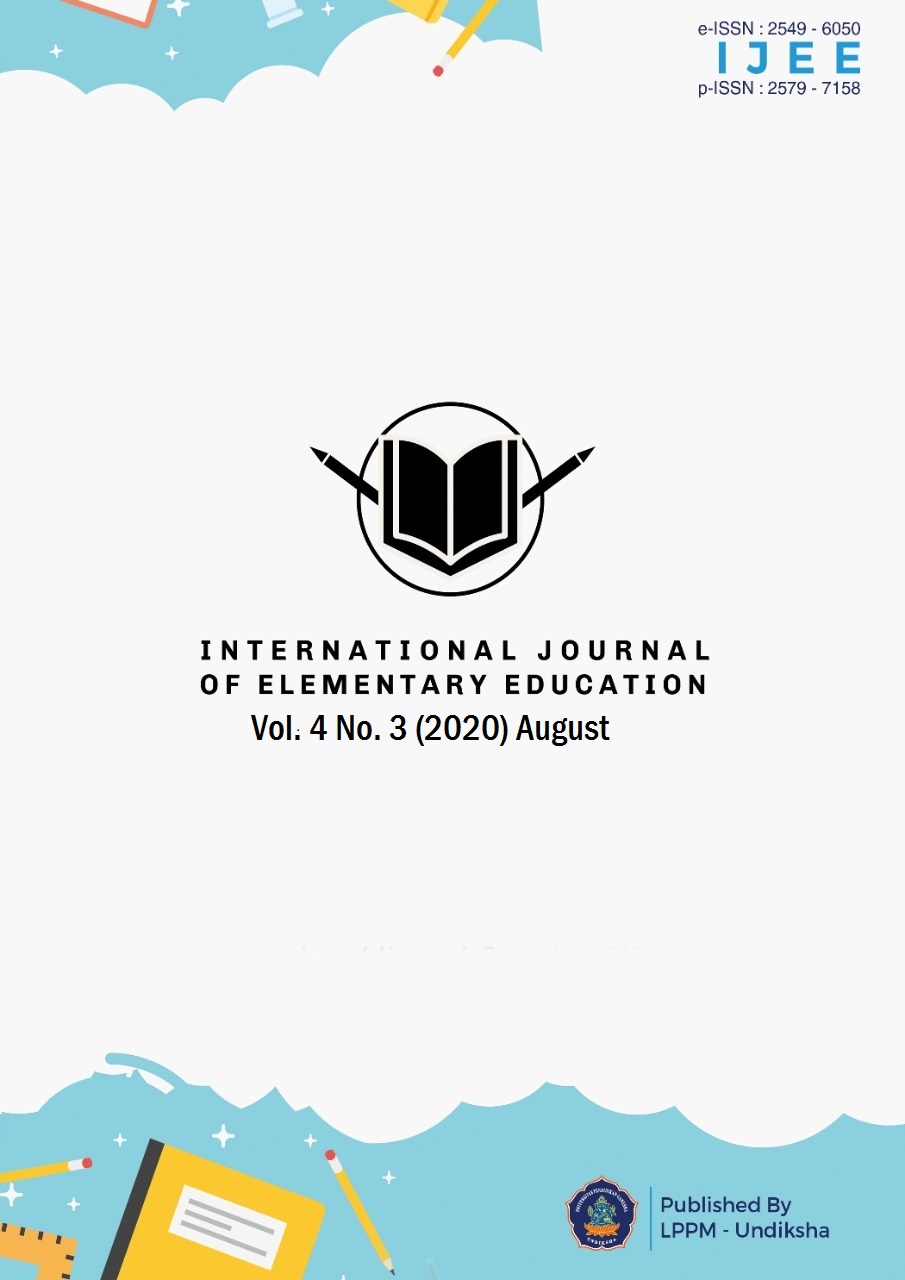Somatic, Auditory, Visual and Intellectual (SAVI) Learning Models Affect Students 'Mathematics Learning Achievement
DOI:
https://doi.org/10.23887/ijee.v4i3.28683Keywords:
SAVI, learning achievementAbstract
The low mathematics learning achievement of students due to the less than optimal use of innovative learning models makes it difficult for students to understand the learning material as the reason why this study was conducted. The purpose of this study was to analyze the effect of the application of Somatic, Auditory, Visual and Intellectual (SAVI) learning. This type of this study was expresearcherimental research, with quantitative data. This study used the experimental design of The Non-Equivalent Group Design. The population of this study were all students of class V, amounting to 61 students. The technique in determining the research sample is random sampling. Test and interview methods were used in collecting research data. The results of data analysis showed that the average mathematics learning achievement of students in the group given the SAVI learning model got 83.6 results while the average mathematics learning achievement of students in the conventional taught group got 61.66 results. The difference can also be seen from the average N gain, namely the experimental class is 0.68 in the quite effective category, while for the average N gain, and the control class is 0.22, in the ineffective category. Thus, there is a significant difference in students' mathematics learning achievement between the experimental class that uses the SAVI learning model and the control class that does not use the SAVI learning model.
References
Alwan, M. (2020). Pengaruh Strategi Pembelajaran Cooperative Learning Tipe Rotating Trio Exchange Terhadap Prestasi Belajar Matematika Siswa Mts. Jurnal Al-Muta’aliyah STAI Darul Kamal NW Kembang Kerang, 5(1), 2502 – 2474. http://ejournal.kopertais4.or.id/sasambo/index.php/mutaaliyah/article/view/3730
Andrianti, Irawati, & Sudin. (2016). Pengaruh Pendekatan SAVI (Somatic, Auditory, Visual, Intellectual) Dalam Meningkatkan Kemampuan Komunikasi Matematis Dan Motivasi Belajar Siswa Sekolah Dasar Pada Materi Pengolahan Data. Jurnal Pena Ilmiah, 1(1), 472–480. http://repository.upi.edu/id/eprint/20718
Anika, & Fajar. (2020). Efektivitas Model Pembelajaran Kooperatif Tipe Make-A Match Dalam Meningkatkan Kompetensi Sikap Siswa dan Kompetensi Pengetahuan Siswa Pada Pelajaran IPS. Jurnal Ilmiah Sekolah Dasar, 4(1), 80–85. http://dx.doi.org/10.23887/jisd.v4i1.24047
Cahyati, A. C., Andriani, L., & Revita, R. (2020). Pengaruh Penerapan Pendekatan Open Ended terhadap Kemampuan Pemahaman Konsep Matematis Berdasarkan Self. 3(2), 125–132. http://ejournal.uin-suska.ac.id/index.php/juring/article/view/9333.
Daryanto. (2011). Media pembelajaran. Jakarta: PT Raja GrafindoPersada.
Donas Ahmad Najib &Elhefni. (2016). Pengaruh Penerapan Pembelajaran Bermakna (Meaningfull Learning) Pada Pembelajaran Tematik IPS Terpadu Terhadap Hasil Belajar Siswa Kelas III di MI Ahliyah IV Palembang. JIP: Jurnal Ilmiah PGMI, 2(1), 19–28. http://jurnal.radenfatah.ac.id/index.php/jip/article/view/1063
Huda, F. A., & Yulianti, I. (2020). Upaya Meningkatkan Motivasi Dan Hasil Belajar Siswa Menggunakan Model Cooperative Learning Tipe Rotating Trio Exchange ( Rte ) Motivasi Belajar , Hasil Belajar Cooperative Learning ( Rte ). 1, 21–26. https://doi.org/10.31932/jutech.v1i1.691
Huda, M. (2014). Cooperative Learning:Metode, Teknik, Struktur, dan Model Penerapan. Yogjakarta: Pustaka Pelajar.
Irfan, & Nasriadi. (2019). Efektivitas Penerapan Model Pembelajaran SAVI Pada Pembelajaran Pecahan. Jurnal Tunas Bangsa Universitas Majalengka, 6(1). https://ejournal.bbg.ac.id/tunasbangsa/article/view/919
Jailani. (2017). Penggunaan Peta Konsep Untuk Belajar Bermakna Dan Peningkatan Pemahaman Siswa dalam Pembelajaran Biologi. Jurnal Biology Education, 6(1), 30–40. https://doi.org/10.1017/CBO9781107415324.004
Khoirudin, M. (2017). Pengaruh Penggunaan Model Pembelajaran Somatis Auditori Visual Intelektual (SAVI) Terhadap Hasil Belajar Matematika Kelas IV SDN 3 Metro Pusat 2017. http://digilib.unila.ac.id/id/eprint/29410
Moma. (2017). Pengembangan Kemampuan Berpikir Kreatif dan Pemecahan Masalah Matematis Mahasiswa Melalui Metode Diskusi. Cakrawala Pendidikan, 36(1), 130–139. Retrieved from https://journal.uny.ac.id/index.php/cp/article/view/10402/pdf
Muniroh, Maftukhin, & Sriyono. (2015). Efektivitas Model Pembelajaran Somatic Auditory Visual Intelectual (SAVI) untuk Meningkatkan Keaktifan dan Hasil Belajar Fisika Siswa Kelas X SMA Negeri 1 Mirit Tahun Pelajaran 2014/2015. Universitas Muhammadiyah Urworejo, 7(1). http://ejournal.umpwr.ac.id/index.php/radiasi/index
Murti, Nasir, & Negara. (2019). Analisis Kemampuan Pemecahan Masalah Matematis: Dampak Model Pembelajaran SAVI ditinjau dari Kemandirian Belajar Matematis. Bandar Lampung. Desimal: Jurnal Matematika, 1(1), 2613–9073. Retrieved from http://ejournal.radenintan.ac.id/index.php/desimal/article/view/4072.
Ngalimun. (2017). Strategi Pembelajaran dilengkapi dengan 65 Model Pembelajaran. Yogjakarta: Parama Ilmu.
Puspita, N. M., Asri, I. A. S., & Ardana, I. K. (2019). Pengaruh Model Pembelajaran Kooperatif Tipe Scramble Berbantuan Media Video Animasi Terhadap Kompetensi Pengetahuan PPKn. Media Komunikasi FPIPS, 17(2), 1–10. https://doi.org/10.23887/mkfis.v17i2.22221
Rahmah, Nur, & Asnida. (2015). Hubungan Penguasaan Perkalian Dan Pembagian Dasar Terhadap Prestasi Belajar Matematika Siswa Kelas VIII SMP PMDS Putra Palopo. Jurnal Elemen, 1(1), 2442–4228. http://e-journal.hamzanwadi.ac.id/index.php/jel/article/view/81
Ruseffendi. (2006). Pengantar Kepada Guru Mengembangkan kompetensinya dalam Pengajaran Matematika. Bandung: Tarsito.
Sugiyono. (2016). Metodologi Pendidikan. Bandung: Alfabeta.
Sutarna, N. (2018). Pengaruh Model Pembelajaran SAVI (Somatic Auditory Visual Intellectualy) Terhadap Hasil Belajar Siswa Kelas IV Sekolah Dasar Dasar. Profesi Pendidikan, 5(2), 119–126. https://doi.org/10.23917/ppd.v1i2.6068
Umbara, & Dkk. (2020). Model Pembelajaran Problem Based Learning Berbantuan Media Gambar Seri BerpengaruhTerhadap Kompetensi Pengetahuan IPS Siswa. Jurnal Mimbar Ilmu, 25(2), 174–186. Retrieved from https://ejournal.undiksha.ac.id/index.php/MI/article/view/25154/15610
Wati, Darsana, & Suardika. (2014). Pengaruh Model Pembelajaran Somatic, Auditory, Visual, Intelectual (SAVI) Berbantuan Bahan Ajar Terhadap Hasil Belajar IPS Siswa Kelas V SD Gugus Raden Ajeng Kartini. Mimbar PGSD Undiksha, 2(1). Retrieved from https://ejournal.undiksha.ac.id/index.php/JJPGSD/article/view/3002/2486
Wiryawan, Murda, & Bayu. (2019). Hubungan Kebiasaan Belajar Dan Motivasi Berprestasi Dengan Prestasi Belajar PKn. Media Komunikasi FPIPS, 18(1), 189–200. http://dx.doi.org/10.23887/jipp.v3i2.18076
Downloads
Published
How to Cite
Issue
Section
License
Authors who publish with the International Journal of Elementary Education agree to the following terms:
- Authors retain copyright and grant the journal the right of first publication with the work simultaneously licensed under a Creative Commons Attribution License (CC BY-SA 4.0) that allows others to share the work with an acknowledgment of the work's authorship and initial publication in this journal.
- Authors are able to enter into separate, additional contractual arrangements for the non-exclusive distribution of the journal's published version of the work (e.g., post it to an institutional repository or publish it in a book), with an acknowledgment of its initial publication in this journal.
- Authors are permitted and encouraged to post their work online (e.g., in institutional repositories or on their website) prior to and during the submission process, as it can lead to productive exchanges, as well as earlier and greater citation of published work. (See The Effect of Open Access)









